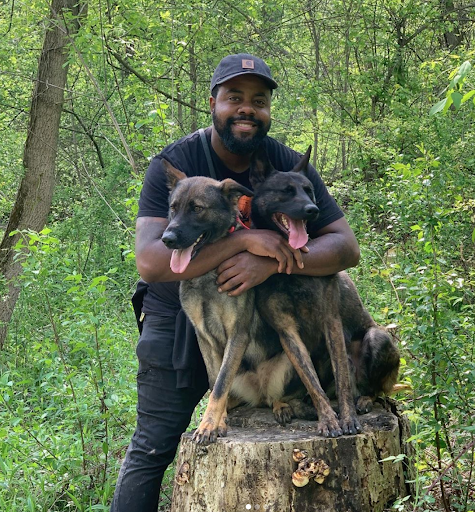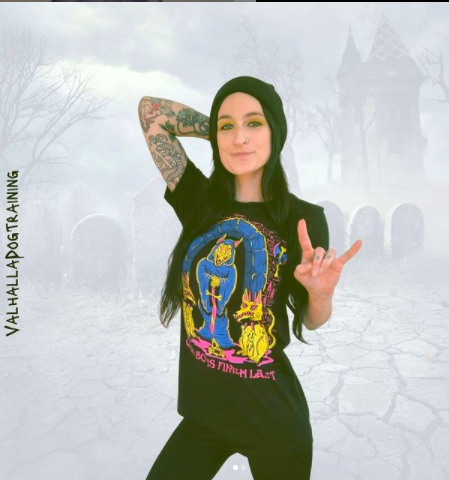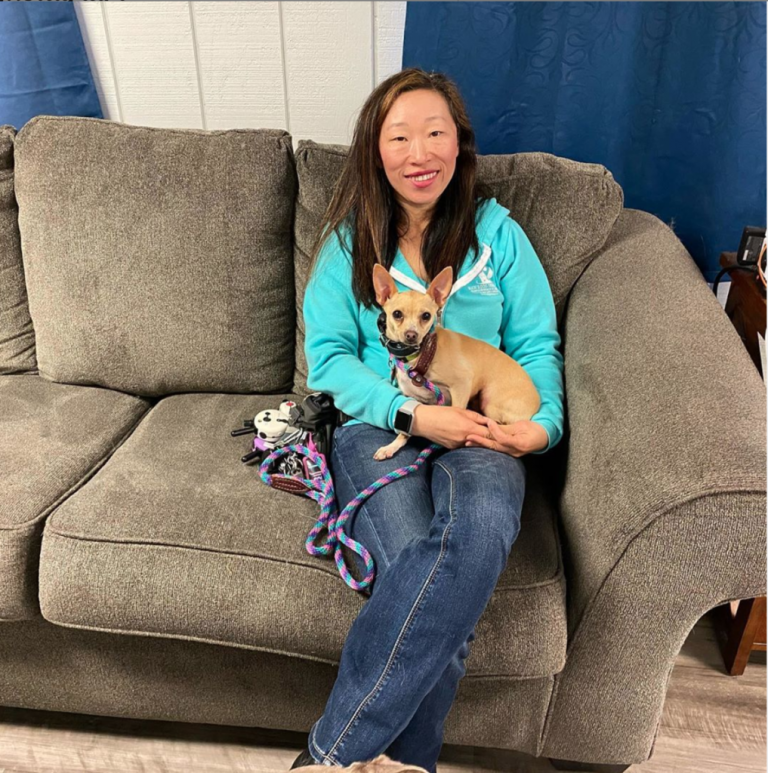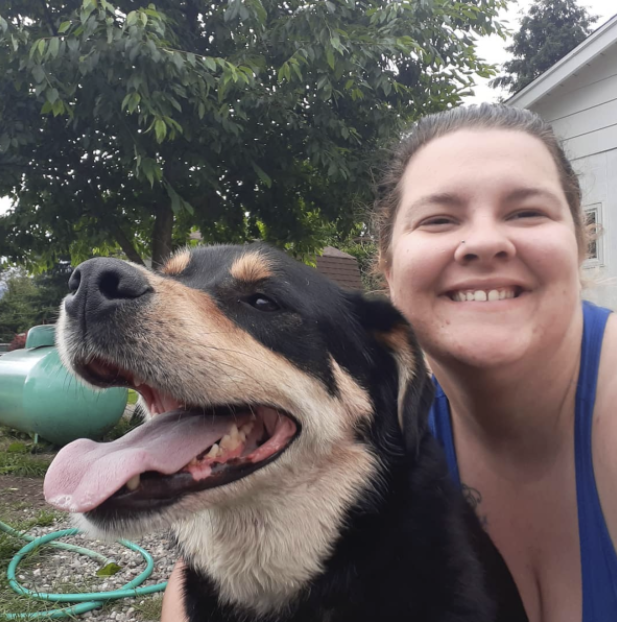
Steve Liggens
 19k
19k
It’s literally all in my hand, like everything I need from invoicing, scheduling, communication, phone numbers. Before it, I had a scheduling app. I had a Google number. I had a questionnaire website. So now, it’s all in one. Literally, I walk around saying, “This app changed my life.” And my boyfriend’s like, “Yes, I know, you said it five times.”

Victoria Carlson
PocketSuite Dog Trainer Pro
Pet Pro, Victoria Carlson (Tori), is a Dog Trainer in Pennsylvania. Her experience training dogs and perfect video editing makes her a great asset to the PocketSuite Pro community. Victoria talks to CEO, Chinwe Onyeagoro, about the various styles of dog training and the concerns with COVID dog adoptions.
How’s it going?
It’s good. It’s busy in the pandemic. Everybody adopted, which is phenomenal, but that makes our job very busy right now.
There’s a whole piece around COVID adoptions. COVID dogs that I want to talk to you about, because it’s a real thing. We have an interest, but we haven’t taken the plunge yet. We are talking to Tori from Valhalla Dog Training. Valhalla Dog Training has been part of the PocketSuite community since December of 2020. We’re super excited to hear what your experience has been and to expose the community to your story.
Absolutely, I’ve been excited about it all week.
Valhalla. I was obsessed with the show Vikings. I fashion myself someone who knows a little something. Is Valhalla like heaven?
That’s absolutely true. That’s the true definition of Valhalla. It’s Viking heaven. It’s heaven warriors. Viking warriors go to this heaven. The way I took it, we have a very heavy Swedish background, and we very much live into that. I have family in Sweden and I dedicate my entire business to my aunt who we lost to suicide. So, the name is very much where I think she is. There’s a long story to it. She’s the one who pushed me to have my own business, so I dedicated it all to her.
That’s amazing. Oh, wow. So, she’s watching over you. You’re helping to create a puppy heaven for lots of families.
Yeah, she’s definitely in Valhalla in our eyes. So, it was an easy choice for me.
Oh, it’s amazing. I was always struck by just the passion and courage that comes with the Viking tradition. It’s funny cause you, you talk about your aunt, but also just recently you posted about somebody called Tom Davis and how he also helped inspire you to start the business. Can you tell us a little bit about that?
Yes. So, Tom Davis is a dog trainer from Upstate New York. He took off early on in the balanced dog training world, but he was very much a vision of a young, tattooed, didn’t go to college, but had a passion and he took off. He has an Academy. Someone bought me a gift of a sweatshirt of his company. He reposted it. I was pretty excited about that. I was a little star struck for a second.
It’s funny because we talk about two things. One is the fact that when most people are coming up they are never told this is something you can do when you grow up. You can make really good money and live a really great life. We’re all sent down these very narrow and predictable paths. When people wake up and they’re like, “I don’t actually like my job, I don’t actually like my life, here’s what I really love doing.” It’s dog training, it’s pet sitting. It’s all of these things that aren’t promoted when you’re coming up.
Absolutely, I will fully admit. In my life, when I said, “I want to be a dog trainer,” it was not at all something that anybody wanted me to do. They didn’t think it was a moneymaker. It’s a moneymaker. Making it in the dog training industry, to me, is $100,000 a year, which is plenty.
Huge, yeah.
I’ve seen that on PocketSuite with the leaderboard comparisons, which kind of opened my eyes that this is being done in other places. They’re succeeding and it’s going really well.
I’m so glad you said that because one of the things we say is, “If you’re at a hundred thousand a year, you’re within the top 20% of earners around the country.” And you can absolutely get there within the dog training industry. They’re really good numbers. I’m glad you’re watching the Leaderboard in PocketSuite, because Pros say, “It’s a motivator.”
Oh, and the message you send. I mean, that’s huge, that’s exciting. For the system that’s helping you do everything to cheer you on like that, is huge.
More where that came from. So Tori, you do a really good job of posting videos of your work. I went through your feed and I’m like, “Oh my gosh, I don’t have a pet, but I get it.” The videos are really clear, they’re very crisp, they’re to the point. They distinguish you. There are a lot of pros who want to add video to their social media, but don’t have the time. Sometimes they don’t have the know-how, in other cases, they just don’t have the resources to do it. Are you an amazing multitasker? You are able to do the dog training services and record it and do all of this stuff at once? That’s super impressive!
Yeah, I definitely get caught for staying up late and working on my iPad. I mean, I’ll fully say, especially to anybody watching, I run my entire business off my iPad. It’s perfect. So, I can go from editing a video to opening up PocketSuite to back to the video. I mean, it’s a lot. I’m a perfectionist in that sense. So, I’m editing till midnight, making sure that it’s perfect. But you’re right, I want it to be. You only have a minute and you know that you can lose people’s attention before a minute’s up. So you’ve got to get in what you can get in within 30 to 45 seconds. It takes time when you have an hour long video to edit.
Do you get good feedback from clients on those videos? For me, if that was for my dog, I’d share it with my friends and family, “Look at how great Spot is doing now!”
Yeah, for that reason and for references from other clients. If we’re working on a command that I’ve posted, I’ll have them refer to that because I try and be very descriptive in the videos so they can understand. Okay, this is what this command means. People love to see their dog on social media. I’m big on pictures. So when a new dog enters our program, I’m sure to post a picture of them up.
We actually have one dog trainer that we interviewed in the PocketSuite Lounge who has a totally separate account for her dog. Her dog has lots, like tens of thousands of followers. I was like, “Wow, that’s amazing!” So Tori, we love to share early stories because I think it’s very easy for people to see the glamour and the glory, but it’s a lot harder for folks to understand what it takes to get there. Can you share a little bit about what it took for you to do what you’re doing right now. Where did you have to push to come up and keep going?
Absolutely. It’s kind of funny you say that too because I just posted today. It is our 1-year anniversary from when we got our LLC. But this business has been 10 years in the making. Slowly but surely, I started apprenticing and doing the knowledge part of dog training. It’s always in the back of my head. I want to be my own boss. I want to open a dog training company. Honestly, I never thought it would happen as fast as it did. It was definitely. Nobody really wanted to quit their full-time job with benefits during a pandemic. I was the first one to say, “I’m out, I’m ready.” It was like you said with the influx of adoptions in dogs, I just felt like it’s now or never. If I fail, then I get a job and I make money again. There was no better time than then. It honestly took me just going for the jump. It took some preparing. I’m definitely known for going and figuring it out later, rather than figuring it out and going for it.
Just do it, yeah.
I think that’s what helped me finally make that jump. I feel like I was the opposite. Logic would tell you not to quit your job.
That’s what they say. “The best companies are created by folks who don’t know what they’re getting into,” because if you really knew …
Absolutely.
If you were to share, “Here are one or two things that you should do to get prepared before you make the leap, what would those things be?”
One of the biggest ones was before I made the jump. I was bartending part-time. So, I still had that little backup, but it gave me the opportunity to work three days in a row, make all the money I needed to in those days. Then, Monday through Friday I was doing the dog training business. So in my industry I can do that. I know a lot of industries where you can’t. The best advice for me, as long as I knew I could cover my bills, then I was ready. I’m all for taking the jump as long as you don’t set yourself back.
Right. So, you’ve mentioned a couple of times about the COVID trend. I’ve got lots of friends who’ve adopted. Can you share with me whether there are any concerns about this influx of folks who may not have otherwise adopted?
Oh, absolutely. There are a lot of concerns.
What are the concerns and how are we getting in front of addressing them? So we don’t see a huge influx of dogs back in shelters when things calm down.
That’s a great question. Not a lot of people are asking that question because they’re unsure of when things will go back to normal. The first thing I can say is there has been an influx of separation anxiety. The new normal is being home with your dog almost 24/7. As some people’s lives have started to go back, I’m getting calls, “I’ve been home for three months, now I’m not and my dog is doing this, this and this.” So, I’m big on positive separation. Even crating your dog when you’re home or having them in another room while you’re home, your dog should not be upset away from you. They should be able to be composed, keep it together. If you flipped it, I know people are upset when they’re not near their dog. But what the dog is showing us is that they can’t function without you there. We really want to practice positive separation, creating increments, 10, 15, 20 minutes at a time. Go out for an hour, come back. Even if you walk around the block, come back, let them out of the crate. Because when you go back to normal and they go in the crate for eight hours, for people who work, they’re not going to be able to handle it.
How do you help folks through this? Do you do the board and train model? Are you onsite with them or is it virtual? What is the mix of services that you provide?
Great question! So, we’re working towards a board and train. We just moved. We moved right into Philly. We got a bigger spot. Yeah, we’re very happy about it. It’s a lot of work though. I’m getting the basement prepared for board and trains. So, right now, I’m traveling. I do in-homes, meaning we’re doing it outside. So, we’re doing it on their property, in parking lots, in public parks, fully masked, which is where the COVID disclosure in PocketSuite has been awesome. So, it’s not just saying, “Yes, I’m not sick,” you’re signing it, big difference. So, I am in homes, but we’re taking all the necessary precautions. I am traveling. I’m on the move 24/7 almost.
We love to ask this question to dog trainers because we’re always surprised by the response. Who’s easier to work with – the dogs or the dog parents?
You asked the inevitable question. Humans humanize. When a dog cries in a crate, they want to go let them out. Trying to convince them not to can be hard. The whole basis of my training is to think like a dog. We can think consciously. We can make conscious decisions. Dogs make snap decisions. So we try to get people to understand that we know why they did that, but we have to teach them why they are making these decisions, instead of just assuming they know things. I can train a dog pretty easily. I’m working on training some people.
Very diplomatic, love it.
Keeping it PG, but yeah.
Are there resources, certification programs, books, any kind of resources where you’re like, “These are gold. If you’re thinking about doing something like this, you should really check it out.”
Yeah, absolutely. I’ll fully admit it’s an unregistered industry. That’s good and bad. There’s very good parts to that, but you obviously have negative sides. We’re balanced trainers. I would say whatever style of training that you’re into, making sure you’re watching the videos. Make sure you’re understanding what you’re doing with the dog – the biggest part of training. First and foremost, I would say Michael Ellis. Anything Michael Ellis based. He has some educational videos. He has Leerburg. He has a school and they’re doing virtual now fully. That would be my first bet. If you’re looking for information just as a person with a dog, I would go on YouTube and find the style of training you’re into.
At PocketSuite, we’ve had our fair share of feedback on this next question. The different dog training styles really evoke lots of emotion from trainers. It doesn’t feel like there’s a right or wrong answer. It feels like there’s a philosophical divide. How did you choose the style that was right for you? How do other people navigate? What mindset would you advise others to use when they’re choosing?
That’s honestly a great question and you’re right. It’s worse than political parties – the different styles of training. I mean, it really is. Social media has definitely intensified the divide. So, I would say that I have a very diverse background. I’ve been in the dog world for over 10 years. Kind of got my start as most people do in daycares and boarding facilities. Then I graduated to being an evaluator at a daycare to running a rescue for a little bit. I ran a rescue for a company, but that’s where you learn the different types of training. I started Positive only. Positive works for a select type of dog. In the rescue world, with dogs that have experienced trauma, there’s an understanding that you can’t communicate with a dog when they’re in that state. I think the biggest misconception about Balance training is that we use these tools to punish and we’re trying to get the dog to submit to us. It couldn’t be farther from the truth, which is why I’m big on virtual consultations. For anyone who’s interested in training with me, we have an hour long consultation, we discuss all of these things. I have a medical background as well in the dog industry. I was a vet tech for some years and now I’m going for my animal science degree in behavior.
So I have a background and it’s not just based on things I’ve read off the internet. We debunk the Pavlov theory. The classical conditioning, Pavlov bell to food. He states in his studies that outside environment issues distract the dogs from the bell, so they weren’t able to hear the bell, because of everything going on around them. We use the E-collar like a cell phone. We communicate with the dog to look in our direction. We talk to it and then trust me, we’re rewarding just as much as Positive. We are just saying, “I want you to do the work first. I’ll pay you after,” instead of, in our eyes bribing. But like I said, Positive only works for some dogs. If you have severe dog reactivity, human reactivity, all of those issues that go under behavior modification, it is kind of hard to communicate with a dog when they’re in that state.
Okay. That’s really helpful. That’s one of the best explanations I’ve heard, “Hey, you know what, if you can do all Positive, do it. And, if the dog needs more, you may need to tap into some other tools and techniques.”
Absolutely, I’ll always start Positive. We’ll see where to go from there.
You alluded to the fact that you’re building out your location for board and train. As you look out into the future, how are you defining success? When will you say, “We’ve arrived!” What is your vision going forward?
Great question. Every day I look at warehouses. Eventually, I’m looking for a large warehouse property. With all of that other training, I’m big into scent training and agility training. If people know the show “Top Dog” on A&E. Yeah, it’s really fun. Most of those dogs are police dogs and fully trained dogs. In our facility, we’re big on rescue. I’m the die-hard rescue advocate till the end. We want to show that your dog may not be on Top Dog to do agility, but there’s no reason they can’t have fun learning at the same time. Doing these courses and scent training, you don’t have to be sniffing drugs to have fun and learn some different ways to stimulate your dog.
Since you’re new, if you could share one or two experiences that you’ve had with PocketSuite that have made an impression on you for folks who are learning more about who we are and our community.
I mean, I have a million, but if I had to knock it down. I would say first and foremost, I’m really good at dog training, but office work – not so much. I’m always moving, like even standing here, my hands are moving. So, sitting down is hard for me. The fact that with a tap of a button, I can send an automated message to somebody is amazing. Invoices are definitely the main thing. I’m so die-hard in my training that I forget that people have to pay me. The subscription payments have been literally game-changing. I didn’t know how much was coming in until I had it on a set schedule. I’ve been told I’m a little bit of a pushover when it comes to going after people to pay me. The system does it for me. It’s preset. They take it as it goes. Then, the video conference tool being able to have a link pre-set in an appointment, I don’t have to pay for Zoom. I don’t have to use Google Meet with terrible connections. It’s literally all in my hand, like everything I need from invoicing, scheduling, communication, phone numbers. Before it, I had a scheduling app. I had a Google number. I had a questionnaire website. So now, it’s all in one. Literally, I walk around saying, “This app changed my life.” And my boyfriend’s like, “Yes, I know, you said it five times.”
I love to hear that. He’s like, “I thought I changed your life.” Haha.
Yeah. He’s like, “I know we love PocketSuite.” And I’m like, “I know, but look.”
Love it! Tori, it’s been awesome talking to you. Thank you so much. Welcome to the PocketSuite community. Keep doing what you’re doing. Let us know how else we can support you.
Thank you. I can’t wait. I’m going to do the same with you guys.



